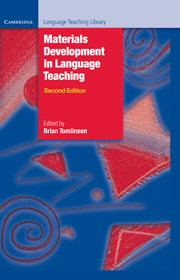Book contents
- Frontmatter
- Contents
- Preface
- Glossary of basic terms for materials development in language teaching
- Acknowledgements
- 1 Introduction: principles and procedures of materials development
- Part A Data collection and materials development
- 2 Using corpora in the language classroom
- 3 Concordances in the classroom without a computer: assembling and exploiting concordances of common words
- 4 Telling tails: grammar, the spoken language and materials development
- Comments on Part A
- Part B The process of materials writing
- 5 A framework for materials writing
- 6 Writing course materials for the world: a great compromise
- 7 How writers write: testimony from authors
- Comments on Part B
- Part C The process of materials evaluation
- 8 The analysis of language teaching materials: inside the Trojan Horse
- 9 Macro- and micro-evaluations of task-based teaching
- 10 What do teachers really want from coursebooks?
- 11 The process of evaluation: a publisher’s view
- Comments on Part C
- Part D The electronic delivery of materials
- 12 Developing language-learning materials with technology
- 13 New technologies to support language learning
- Comments on Part D
- Part E Ideas for materials development
- 14 Seeing what they mean: helping L2 readers to visualise
- 15 Squaring the circle – reconciling materials as constraint with materials as empowerment
- 16 Lozanov and the teaching text
- 17 Access-self materials
- Comments on Part E
- Conclusions
- Recommended reading
- Index
3 - Concordances in the classroom without a computer: assembling and exploiting concordances of common words
Published online by Cambridge University Press: 09 February 2023
- Frontmatter
- Contents
- Preface
- Glossary of basic terms for materials development in language teaching
- Acknowledgements
- 1 Introduction: principles and procedures of materials development
- Part A Data collection and materials development
- 2 Using corpora in the language classroom
- 3 Concordances in the classroom without a computer: assembling and exploiting concordances of common words
- 4 Telling tails: grammar, the spoken language and materials development
- Comments on Part A
- Part B The process of materials writing
- 5 A framework for materials writing
- 6 Writing course materials for the world: a great compromise
- 7 How writers write: testimony from authors
- Comments on Part B
- Part C The process of materials evaluation
- 8 The analysis of language teaching materials: inside the Trojan Horse
- 9 Macro- and micro-evaluations of task-based teaching
- 10 What do teachers really want from coursebooks?
- 11 The process of evaluation: a publisher’s view
- Comments on Part C
- Part D The electronic delivery of materials
- 12 Developing language-learning materials with technology
- 13 New technologies to support language learning
- Comments on Part D
- Part E Ideas for materials development
- 14 Seeing what they mean: helping L2 readers to visualise
- 15 Squaring the circle – reconciling materials as constraint with materials as empowerment
- 16 Lozanov and the teaching text
- 17 Access-self materials
- Comments on Part E
- Conclusions
- Recommended reading
- Index
Summary
Introduction
In recent years there has been growing interest in corpus linguistics, corpora in the language classroom and using concordances for language learning. Mauranen ( 2004 ), O’Keeffe, McCarthy and Carter ( 2007 ), Römer ( 2006 ), Sinclair ( 2004 ) and Chapter 2 in this volume all bear this out. And it is not just linguists and lexicographers, grammarians and materials writers who stand to gain from new insights into language use through these developments, but teachers and learners as well. In 1991 Tim Johns published his seminal paper ‘Should you be persuaded – two samples of data-driven learning materials’, illustrating how learners can benefit from becoming language investigators in their own right:
The use of the concordancer can have a considerable infl uence on the process of language learning, stimulating enquiry and speculation on the part of the learner, and helping the learner also to develop the ability to see patterning in the target language and to form generalisations to account for that patterning.
This inductive data-driven approach, with its element of ‘challenge and discovery’ ( ibid .), is in itself a valuable educational experience and one for which, as I go on to show, computers are not essential.
Later in this chapter I illustrate five different ways in which teachers can exploit sets of concordance lines that their learners have assembled by hand, without a computer. This Do It Yourself (DIY) approach is suitable for all classrooms as it engages learners (from beginners upwards) in collecting and analysing language data for themselves. It is especially applicable to classroom situations where people do not have access to technology, though it can be enhanced by use of hi-tech back-up, if available, outside class.
From corpus to concordances
How do researchers set about the task of describing language? Let us imagine that a researcher wishes to study the language of three-year-old children to see if there is any difference between the language of boys and girls at that age. Usually the first step is to gather a corpus (which can be stored electronically), a body of the relevant language, in this case the language of three-year-old boys and girls.
- Type
- Chapter
- Information
- Materials Development in Language Teaching , pp. 51 - 77Publisher: Cambridge University PressPrint publication year: 2011
- 5
- Cited by



